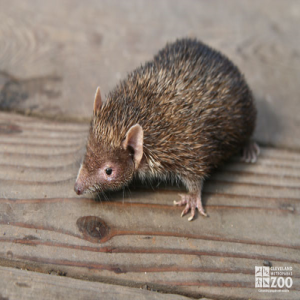 The Lesser Madagascar Hegehog Tenrec is a species of mammal within the family of Tenrecidae and is endemic to Madagascar. They are not related to the greater tenrecs. Although they may resemble hedgehogs, they are not related. Their body spines were adapted through “divergent evolution” and their closest relatives are golden molels and elephant shrews whose relationship was not recognized until the late 1990’s. They are typically 5.5 to 7.0 inches long, and weigh about 4 to 7 ounces.
Their backs are covered in sharp spines of varying color, from tan or off-white to dark brown-black. The belly, face and legs are not covered in spines, but short, soft hair. They have barely visible short tails, prominent ears, 5 toed feet with sharp claws and many whiskers on the face. Their eyesight is poor, whiskers are sensisitive, and hearing and sense of smell are well developed. To seek shelter they make dens in tree cavities. Males and females cannot be differentiated externally. They are a widespread and an adaptable species. They are not endangered and are relatively stable. Lifespan in wild 8-10 years, in captivity about 13 years.
The Lesser Madagascar Hegehog Tenrec is a species of mammal within the family of Tenrecidae and is endemic to Madagascar. They are not related to the greater tenrecs. Although they may resemble hedgehogs, they are not related. Their body spines were adapted through “divergent evolution” and their closest relatives are golden molels and elephant shrews whose relationship was not recognized until the late 1990’s. They are typically 5.5 to 7.0 inches long, and weigh about 4 to 7 ounces.
Their backs are covered in sharp spines of varying color, from tan or off-white to dark brown-black. The belly, face and legs are not covered in spines, but short, soft hair. They have barely visible short tails, prominent ears, 5 toed feet with sharp claws and many whiskers on the face. Their eyesight is poor, whiskers are sensisitive, and hearing and sense of smell are well developed. To seek shelter they make dens in tree cavities. Males and females cannot be differentiated externally. They are a widespread and an adaptable species. They are not endangered and are relatively stable. Lifespan in wild 8-10 years, in captivity about 13 years.
Location: Education Animals
Share:
Range
Southern and Southwestern Madagascar
Habitat
Prefer dry areas such as dry forests, scrublands, agricultural areas, dry coastal regions. And semi-desert regions
Conservation Status
Least Concern
Primary Threats
Gestation
About 61 to 68 45 days after mating, females give birth usually in the wet season when the maximum amount of prey is available
Litter
1-10 young (normally 5-7)
Behavior
They are nocturnal; go into torpor for 3 to 5 months during the cold season; if threatened- they roll into a ball to protect their underbelly or lunge backwards to drive their spines into their enemies; to seek shelter they make dens in tree cavities.
Reproduction
Sexually mature after they have gone through their first cold season in torpor. Unusual among placental animals, females have a cloaca (a single opening for reproductive, intestinal, and urinary purposes). Breeding occurs within several days of coming out of torpor. During colder years, may remain in torpor later.
Wild Diet
Omnivorous: Eat insects and their larvae, eggs, spiders, and occasionally fruit and occasionally small mice.
Zoo Diet

